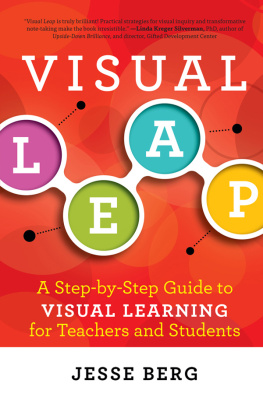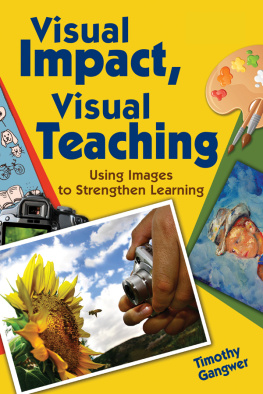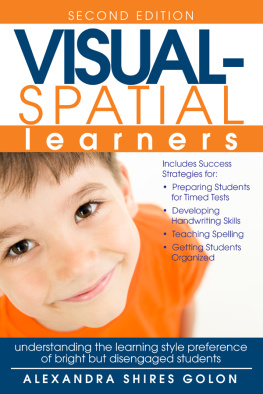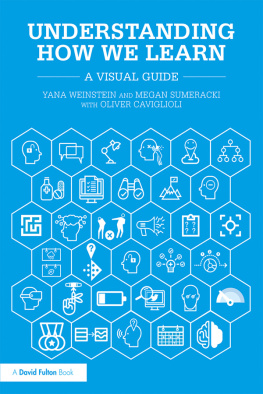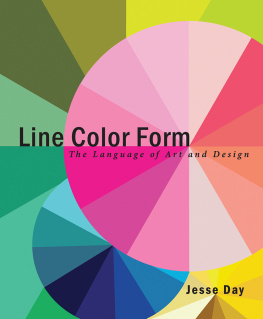
Praise for Visual Leap
and Jesse Berg
Visual Leap is truly brilliant! Jesses innovative BOWL and LADLE technique to make SOUP, his ingenious Summary Man, and all of his practical strategies for visual inquiry and transformative note-taking, make the book irresistible.
Linda Kreger Silverman, PhD, author of Upside-Down Brilliance: The Visual-Spatial Learner, and director, Gifted Development Center
Visual Leap strategies can be a staple for any classroom teacher to help students learn to make connections and think critically. Jesse recently presented in my district and there were many aha moments as teachers saw how simple it could be to differentiate instruction and meet the challenges of the Common Core.
Michael Coppotelli, associate superintendent of schools, Archdiocese of New York
Since the day Jesse Berg walked into my classroom, his techniques and visual learning strategies have helped my students develop the confidence they needed to succeed. Visual Leap is innovative, intuitive, and courageous and will help many more students become fully invested as owners of their education.
Desmond Kirton, CTE teacher, school district of Philadelphia; recipient of the 2015 Lindback award for distinguished high school teachers
Jesse Bergs book is a valuable addition to the much-needed topic of how to teach visual learners. It is excellently written and replete with great ideas and practical methods for teachers to use in class.
Jeffrey Freed, MAT, author of Right-Brained Children in a Left-Brained World: Unlocking the Potential of Your ADD Child
These visual learning strategies are a genuinely revolutionary step forward for writing and thinking skills across the academic spectrum. I know this from personal experience because these methods helped me unsnarl a difficult paper I was working on. Now I use the mapping techniques Jesse Berg presents in Visual Leap to plan many of my lectures and articles.
Michael Weingrad, PhD, professor, Portland State University
Jesse played an integral part in my daughters life. She has ADHD and auditory processing issues. Mr. Berg encouraged her when all others (including teachers) were telling her she would not go very far. She recently graduated from a top-rated university and is now working as a senior software engineer at a major corporation. Visual Leap will help many students realize that they too can put their minds to anything they want to do.
Iris Roth, parent
Ive always had a hard time learning new things and concepts. But with mind mapping, and other techniques that I learned in the Visual Leap workshop, I can express the information I receive in a way that is natural for me. I always felt that I was slower than the other kids, that I was dumb. Now I feel like I can go to college. Thank you for teaching me how to learn.
Karim Keita, high school graduate
VISUAL LEAP
VISUAL LEAP
A Step-by-Step Guide to
VISUAL LEARNING
for Teachers and Students
JESSE BERG, MSIT, MEd

First published in 2015 by Lamprey & Lee, an imprint of Bibliomotion, Inc.
711 Third Avenue, New York, NY 10017, USA
2 Park Square, Milton Park, Abingdon, Oxon OX14 4RN, UK
Bibliomotion is an imprint of the Taylor & Francis Group, an informa business
Copyright 2015 by Visual Leap, LLC.
All rights reserved. No part of this publication may be reproduced in any manner whatsoever without written permission from the publisher, except in the case of brief quotations embodied in critical articles and reviews.
ISBN-13: 978-1-942108-07-8 (hbk)
[CIP data has been applied for]
This book is dedicated to everyone who has ever needed a go-to strategy to solve a problem, think more clearly, learn something new, or communicate a complicated idea. It is dedicated to the vast effort we put into teaching, learning, planning, getting out in front of our ideas, breaking down the barriers to achievement, and accomplishing our goals, whatever they may be. The future rides on our ability to think, learn, and create. This book is dedicated to making it easier for us to reach our destinations.
CONTENTS
I believe with all my heart that visual thinking can change lives. Why do I believe this? Because it has changed my life, and I am just like millions of other people with ideas who struggle to develop and execute them. For me, and for a vast number of smart and creative people, the simple visual thinking strategies outlined in this book can transform our ability to produce in the world, realize dreams, and solve problems, no matter how complex. If these strategies work for you like they have worked for me, I promise that your intellectual confidence will grow by leaps, bolstered by your enhanced ability to organize and develop your ideas, plan a course of action, and accomplish your goals.
Writing this book has been the most difficultand most terrifyingthing I have ever done. However, I feel compelled by the need to share these ideas. My fear stems from two things: (1) dying with regret and (2) my proclivity to do things 90 percentthe first 90 percent. I am not blessed with willpower and perseverance. I embrace distraction. I love immediate gratification and frequent breaks. I hate grit. Despite these tendencies, I was driven to finish this book because its very content made it possible for me to embark upon and complete this monumental task. Finishing it is a huge relief, and failing to do so would have been a haunting regret.
The process of visual thinkingwhich I used to write this book and which I explain in these pagesis the most important thing I have to teach. If you are reading this book, half of my mission is complete. However, if taking the Visual Leap helps you or your students, then my bucket will truly be filled.
INTRODUCTION
Why You? Why Now?
This book is geared primarily toward K12 educators, though, more broadly, it is for anyone who needs a go-to strategy for learning, problem solving, and organizing ideas. It focuses on the needs of teachers because, more than anyone else, they are the ones with the opportunity to provide our next generation with the skills needed to navigate and succeed in an ever-changing world, a world where the life span of useful knowledge is perpetually decreasing and the need to learn, adapt, and retool is constant.
Visual Leap explains how to think visually and how to teach the skill of visual thinking to others. The explicit, step-by-step method it delivers is effective and easy to master because it matches how human beings naturally learn. Visual thinking skills enhance intellectual curiosity and academic perseverance by providing a framework to help students remember, analyze, and create. Since it is a thinking strategy, the approach is applicable to learning virtually any type of idea or academic content, and it universally helps students improve reading comprehension, write more effectively, and even listen better.
Beyond teaching specific skills, however, this book aims to help people learn how to think for themselves. The ultimate goal is to nourish students with strategies they can use independently in diverse situations when the questions they have to solve are open-ended and have no clear-cut right or wrong answers. In addition, if you or your students would benefit from writing more efficiently, learning more easily, or solving problems more creatively, then this book is for you.
Next page
